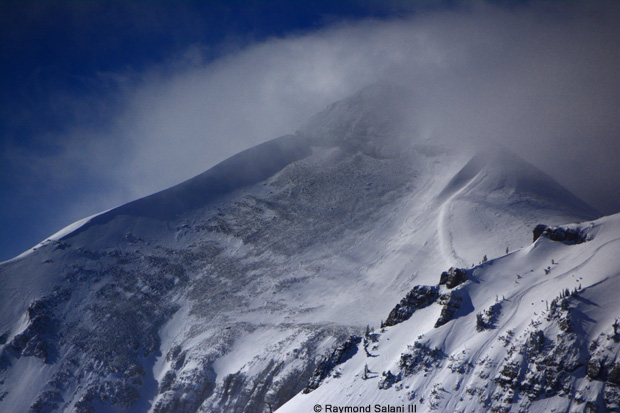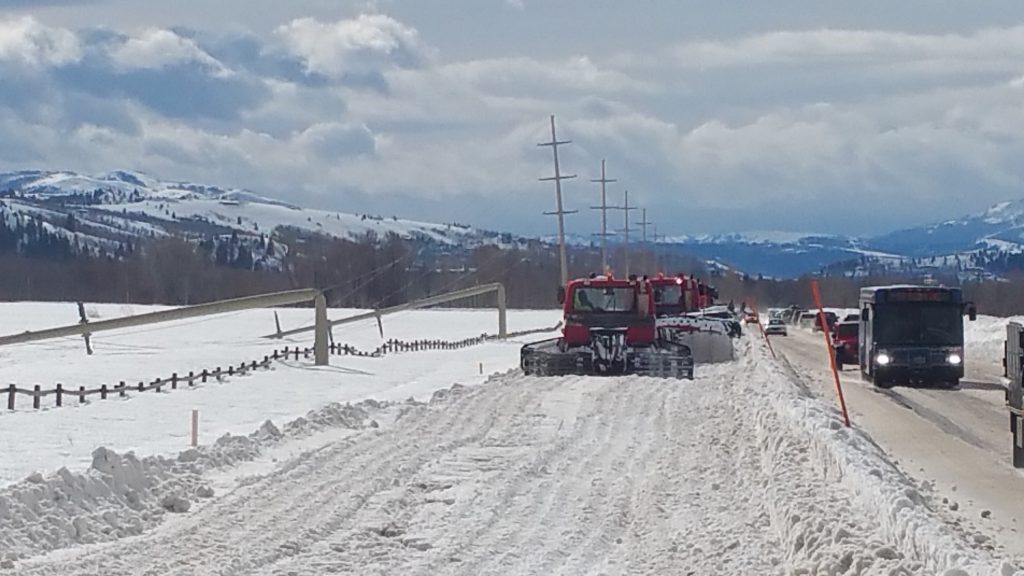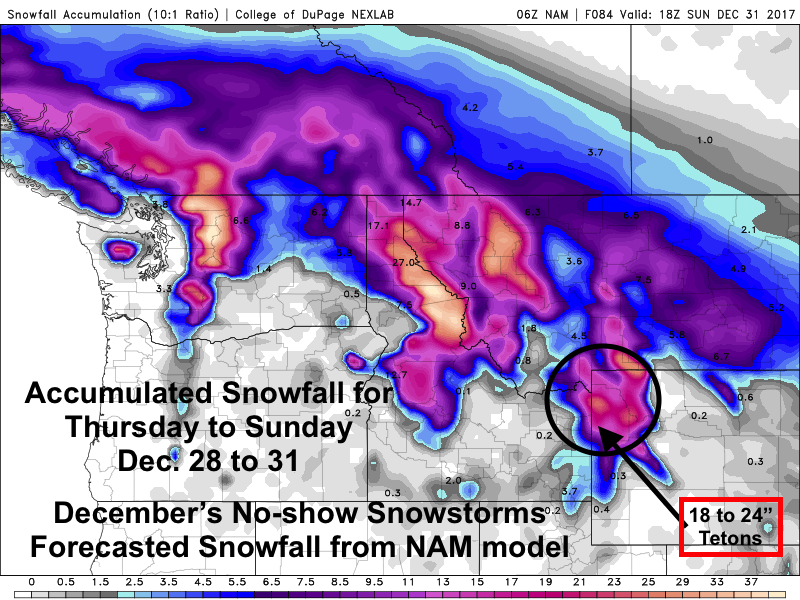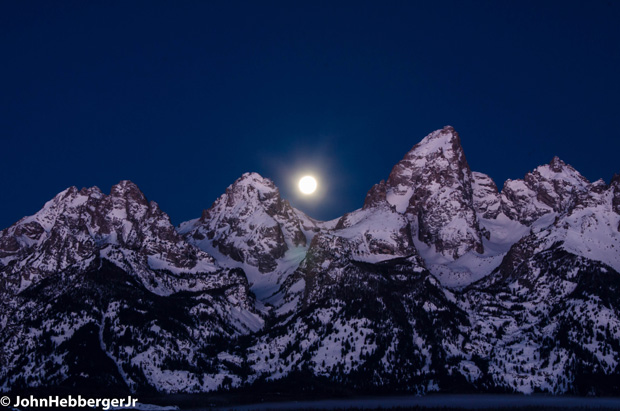
All posts by Jim Woodmencey
Winter 2017-18 Jackson Hole
This post will compare snowfall and water amounts in the Town of Jackson and the Teton Mountains to last winter’s epic snow and water amounts, as well as, to the historic averages. Most of the contents of this post were recently published in the Jackson Hole News & Guide.
Town Snow and Water
In the Town of Jackson, between December 1st, 2017 and April 1st, 2018, 51 inches of snowfall was recorded. The average snowfall in town for December through March is 61 inches. Last year during this same timeframe, we received way above normal snowfall, with 94 inches recorded.
Water-wise, the Town of Jackson had a total of 6.31 inches for December through March 2017-18, compared to an average for these four months of 5.39 inches. So, a bit below for snow, and a bit above for water amount, in town this winter.
Last winter, the town received an unheard of 12.94 inches of precipitation (over a foot of water) for the four-month period, which was a record and more than twice the historic average.

Mountain Snow and SWE
Using data from the Rendezvous Bowl weather plot at the Jackson Hole Mountain Resort, at the 9,580-ft. elevation, the total snowfall from December 1st, 2017 to April 1st, 2018 was 330 inches. The historic average for that weather station, for the four-month period, is 302 inches. That puts this winter’s “ski season” snow total at almost 110-percent of average.
For the same time period the previous season, 2016-17, there was 462 inches of snowfall, or eleven feet more snowfall than this winter,
Looking at the total snowfall from the beginning of this winter season, from October 1st, 2017 to April 1st, 2018, the total snowfall was 465 inches. That is 79 inches more than the historic average snowfall between October 1st and April 1st, which is 386 inches. That calculates out to a total winter snowfall that was 120-percent of normal.
The extra snow we had in October and November this year made a big difference on pushing us well above the average.
The previous winter, 2016-17, between October 1st and April 1st, Rendezvous Bowl received 560 inches. That was about 95 inches, or nearly eight feet, more than this season.
Another metric by which we can gauge the winter season in the mountains is to look at the settled snow-depths. This provides perhaps the best measure of how much of that snowfall actually stuck around.
Settled snow depths at the Rendezvous Bowl site on April 1st, 2018 stood at 131 inches. That would be 127-percent of the average snow depth on April 1st, which is 103 inches. Last year on April 1st, the snow depth was 146 inches
So, as of April 1st this year, there was only 15 inches less snow depth than on April 1st, 2017. Translate that to mean, we still have plenty of snow to melt this spring.
Speaking of water amounts, what we call the Snow Water Equivalent or SWE (pronounced “Sweee!”); at the Phillips Bench SNOTEL site, at the 8,200-ft. elevation, SWE was at 115-percent of the median value for April 1st. Grand Targhee’s SNOTEL site, at around the 9200-ft. elevation, was at 122-percent of the median.
(Note: “Median” is the number where half of the data is higher than that number and half the data is below that number. In the case of SWE, the data set used is from 1981-2010.)

Bottom-line: Ideal Winter
Those are all the hard numbers from this winter, the soft version is: we had another above normal snowfall year in the mountains, coupled with below normal snowfall in the valley.
In my mind, that is an ideal winter. This year I didn’t waste as much time shoveling snow out of my driveway, before I could get to the mountains to ski powder. I can’t say that about last winter.
Jim is the chief meteorologist at mountainweather.com and has been forecasting weather in Jackson Hole and the Teton Range for more than 25 years.
Wild Weather Februarys
In the seven-day period following Valentine’s Day this year, the Jackson Hole valley became blanketed in snow again, after enduring what I will call a “brown-out” during late January and early February. Six inches of settled snow depth was reported at the Jackson Climate Station at the end of last week.
The mountains picked up about four more feet of snow. By February 21st, settled snow depths on the upper mountain stood tall, at 100 inches. That’s 10 inches more than the average for this time of year.

As far as temperatures, well, they went backwards. We got used to seeing highs in the 40’s in late January and early February. Last week they dropped back down, with highs only in the teens and twenties. Along with, a few days with morning low temperatures in the single digits below zero, like we haven’t had since New Year’s Day.
This year, it was more like January in February. Which does not surprise me. February has been known to have some kick-ass weather. We only need to look back to last year’s storm to know that much.
In this post, I will look back at the three wildest February’s that I can recall since I came to Jackson Hole over 35 years ago; those were: 2017, 2000, and 1986. Each of these had unique and quite severe weather, during a month when winter is supposed to be going into its waning phase.
February 2017
In early February 2017, we experienced what has been called the “Storm of the Century” for Jackson Hole. It began right around Groundhog’s Day. On February 7th, the “big blow” took down the powerlines along the Teton Village Road.

That wind was just a part of a storm cycle that spanned the first 11 days of the month. In that period of time, over 3 inches of water equivalent was recorded in the valley and 10 inches of water equivalent in the mountains. Which translated to 17 inches of snow in town and 92 inches of snow at the higher elevations in the mountains.
Last February went on to break the precipitation record for the month of February in town, with 5.75 inches of water recorded at the Jackson Climate Station. That’s over two inches more than the previous February record.
February 2017 also broke the all-time snowfall record for February at the Jackson Hole Mountain Resort, with 149 inches of snow recorded at the Rendezvous Bowl weather station. The old record was 134 inches from just a four winters ago, in February 2014. An “average” February on the mountain sees 69 inches.
February 2000
It was on February 14th, 2000 that we had the St. Valentine’s Day storm. That storm was pretty much a one-day wonder, but it packed quite a punch. On the morning of February 14, 2000, a vigorous low-pressure system was moving inland across Idaho. It snowed hard in Jackson early that morning, but changed to rain by afternoon in the valley.
A strong cold front then moved across eastern Idaho in the late afternoon, with severe thunderstorms developing, along with tornadoes, which took down transmission lines in eastern Idaho, resulting in a power outage Valentine’s evening in Jackson.
Thunderstorms passed through the Jackson Hole area, also. Colder air changed the precipitation from rain to sleet to hail, and then to big, fat, heavy, wet snowflakes. This was a rare “thundersnow” event for Jackson Hole. Strong downdrafts of wind were also reaching a peak as these thunderstorms moved through.
Wind speeds averaged over 40 mph, with gusts topping out at 66 mph at the Jackson Hole Airport. Visibility was reduced to near zero around the valley in heavy snowfall, and blizzard conditions existed over the mountain passes.
Winds at the top of the tram were honking at a steady 50 mph, with gusts over 90 mph. When it was over, 17 inches of new snow containing over one-inch of water was recorded at the Jackson Hole Mountain Resort on Valentine’s Day 2000.
February 1986
Last but not least, the storm period we had here between February 12th and February 23rd, 1986 was in many was more intense than the February 2017 storm cycle. Total precipitation in town during that period exceeded four inches.
At the Jackson Hole Mountain Resort, for that 12-day period, there was 110 inches of snow accumulation on the upper mountain, and that snow contained 12.50 inches of water.

That intense February of 1986 storm period produced 18 more inches of snow in the mountains and 2.50 more inches of water than what we received, in roughly the same number of days, as the storm in February 2017.
While we tend to start thinking about milder weather in February, the reality is, it can still get pretty darn western here.
Jim is the chief meteorologist at mountainweather.com and has been forecasting the weather in Jackson Hole and the Teton Range for the past 25 years.
Note: Content for this post first appeared in the Jackson Hole News & Guide’s Mountain Weather column on February 28, 2018.
Sunrise Northern Teton Range
Rendezvous Peak
Jackson Peak
Jackson Hole 2017 Weather Review
This is my annual summary of the weather for Jackson, WY for the year 2017. At the bottom of this post a re-cap of the weather highlights from 2017 in Jackson Hole.
All data included in this weather summary is taken from the Jackson Climate Station. The historic averages and totals are from the official records, including all years with complete data, between 1905 and 2016.
Precipitation
The total precipitation received in 2017 was 23.27 inches. That is 147-percent of the long-term average annual precipitation of 15.84 inches, or more than ten inches of excess precipitation.
Much of that was due to the very wet & snowy months of January and February. However, September and November were also exceptionally wet, with more than double their respective averages for precipitation.
The wettest month of the year was February, with a massive 5.75 inches of water in town, from rain and snow combined. That broke the old February record of 2.83 inches in 1962, by a wide margin. On average, February is usually one of the driest months of the year, averaging just 1.14 inches of precipitation.
The driest month of 2017 was August, with less than three-quarters of an inch of precipitation.
Snowfall
No one needs to be reminded that last winter was snowier than normal. January and February 2017 snowfall totals combined were almost twice the norm, 62 inches of snow fell in town those months, compared to an average total for these two months of 33 inches.
Other than that, October 2017 was the only other month for the rest of the year that saw above average snowfall.
We also don’t need to be reminded that December 2017 under-performed in the snowfall department, with just over 8 inches of snow for the month. That is about half of the long-term average snowfall for December, of 17 inches.
The total annual snowfall for Jackson in 2017 was 90 inches. Which actually includes parts of two winters. But, that was well above the long-term average annual snowfall in town of 77 inches.
Temperatures
It was an interesting year temperature-wise in Jackson. Average high temperatures came in below normal 8 out of the 12 months. Whereas, average monthly low temperatures registered above normal 9 out of 12 months.
That is not surprising in a year that had above normal precipitation. A wet year usually translates to more cloud cover, and thus, cooler daytime temps and warmer overnight temps.
In the end, our annual average high temperature in 2017 was 52-degrees, or two degrees cooler than the average of 54-degrees.
The average low temperature for the entire year was 26-degrees, or 3 degrees warmer than the long-term average of 23-degrees.
The annual mean temperature for the entire year of 2017, or the average of the average annual high and low temperatures, calculates out to be 39-degrees. And surprisingly, that was pretty darn close to the long-term average mean temperature for Jackson of 38.5 degrees.
Summary
The weather in 2017 was a little bit wetter and snowier than it was in 2016, and both of the last two years were wetter and snowier than the long-term averages.
At the same time, 2017 managed to maintain what would be considered a perfectly normal range of temperatures. Annual mean temps were identical to 2016, and were also about as close as you can get to nailing the average annual temperature, from the last 100 years of data.
2017 Seasonal Weather Highlights
Winter Season
The Winter of 2016-17 re-set the bar for snowfall in the mountains. It also tested our limits for how much snow we really want to have to shovel or plow in the valley. Beginning in early December 2016, we went from a settled snow depth in town on December 1st of just one inch, to a depth of 18 inches on Christmas Day 2016.
January and February 2017 continued the trend of copious snowfall, tapering off early in March. Almost 100 inches of snow fell in town between December 1st, 2016 and April 1st, 2017. That is well above the average winter snowfall in town of 61 inches.
December and January also saw wild temperature swings. For instance: the low temperature in town on January 6th, 2017 was 32-degrees below zero, that was also the coldest day of 2017. On January 8th, the high temperature was 37-degrees, above zero. A 69-degree swing in two days!
Mountain snowfall was nothing short of huge last winter. At the Jackson Hole Mountain Resort, during the “ski season”, between December 1st, 2016 and April 1st, 2017, the total snowfall was 462 inches. That was from the Rendezvous Bowl study plot at 9,580-feet, which averages 301 inches of snow for this same time period. The only bigger “ski season” snowfall was in 1996-97 with 486 inches. That was twenty years ago.
Total snowfall in Rendezvous Bowl during February alone was 149 inches, making that the snowiest February ever on the mountain.
The single biggest weather event of winter was the storm that toppled the transmission lines on the Teton Village road on February 7th, 2017, during a winter storm cycle like we hadn’t seen since February 1986, some 30 years ago.
Spring 2017
Cold and snowy weather most of the winter, gave way to an early spring. Warmer than normal temperatures in March of 2017 essentially vaporized the snow in the valley. We began the month with 14 inches of settled snow on the ground in town. By March 18th, it was all gone.
Snow was still accumulating in the mountains into April. Enough to push the total winter snowfall number, from October 1st to April 9th, in Rendezvous Bowl to a record 590 inches. That edged out the old record of 585 inches from 1996-97, for that same time period.
April and May 2017 both ended up cooler than normal, but drier than average, in town.
Summer 2017
That theme of cooler-than-normal temperatures extended through the summer. June, July and August all experienced below normal high temperatures. The hottest day of the year came on the Fifth of July, when it hit 89-degrees in town.
June and July were both wetter than normal, while August was quite dry. August was also a smoky month, from forest fires burning to the west of us in California, Idaho and Montana. People worried that the smoke would be around and ruin the biggest event of the summer.
The Total Solar Eclipse on August 21st, 2017 was that event, and a very weather dependent one. Luckily the smoke had departed before the big day. However, a band of high overcast clouds came over Northwest Wyoming very early that morning, which could have potentially dimmed the viewing experience.
Fortunately, those clouds exited off to the southeast of Jackson Hole an hour or so before the start of the eclipse, and we had as clear of view of this incredible spectacle as you could hope for.

Fall 2017
Summer came to an abrupt end, on the last day of summer. The high temperature in town on September 21st, 2017 was only 41-degrees. That was a record cold maximum temperature for that date. Making it the coldest last day of summer ever in Jackson.
With that cold, came our first dump of snow in the mountains, coating them completely white, top to bottom. September went on to be much wetter than normal in town with almost 3 inches of water, more than making up for a dry August.
October was near normal precipitation-wise, then November stepped up to register almost twice the average precipitation. Temperature-wise, September and October were both colder than average. November was just above average.
We shoveled snow in town in both October and November, and backcountry skiing commenced very early this fall on Teton Pass. Snow depths reported at the upper elevations of the Jackson Hole Mountain Resort exceeded four feet by Thanksgiving.
A drought early this December, with no new snow between December 6th and 13th, 2017, had folks worried about a brown Christmas. Snow during the days leading up to Christmas weekend helped the skiing conditions up high, and provided a White Christmas in town.
Along with milder temperatures, it was certainly a much different December than we had in 2016.
Jim is the chief meteorologist at mountainweather.com and has been forecasting the weather in Jackson Hole and the Teton Range for the past 25 years.
Note: The contents of this post first appeared in the Jackson Hole News & Guide On January 3rd & January 17th, 2018.
Models Get This One Right
During the last week of December 2017 the computer models performed so poorly, by grossly over-forecasting snow accumulation over the northern Rockies, that I was about to give up on them.
This week is a different story, they all handled the situation this second week of January very well. If anything, they under-forecasted snowfall amounts this week.
Jackson Hole Mountain Resort and Grand Targhee Resort received 10 to 16 inches of new snow just in the last 24-hours. And, 24 to 30 inches total for the week!
Below is the Snowfall accumulation Forecast from the NAM Model,
for Thursday a.m. to Friday, courtesy of NexLab: Click pic to play video.
Below is the Snowfall accumulation Forecast from a HiRes WRF Model,
courtesy of CAIC: Click pic to play video.
Pretty right-on this week.
Whew!
Post by Meteorologist Jim Woodmencey
Full Moon Setting
“No-show” Snowstorms December 2017
In my 25 years of forecasting the weather for Jackson Hole and the Teton Mountains, I have never experienced a forecast period that was as big a bust as this past week. Between the Christmas and New Year’s Weekends, as much as two feet of snow was forecast, and less than 6 inches accumulated.
In my more than 30 years as a meteorologist I cannot recall a time when the computer models were this far off in their guidance. Not just one model, all of the computer models that I consulted (7 different ones) had forecast copious amounts of moisture and mountain snowfall. They were all wrong. Thus, so was I.
In a December without much snow, the promise of a big dump is taken seriously in a ski town. And, I don’t take it lightly when it doesn’t materialize. Especially when it seemed to be a sure bet that the Teton Mountains would get plenty.
Maybe not the huge dumps like we were getting last December (2016), but in relative terms, a foot of new snow means a lot.
First No-Show
The first busted forecast was on Wednesday, December 27th. I had forecast 3 or 4 inches in the mountains during the day and another 2 or 3 inches Wednesday night. I figured over that 24-hour period the Tetons would see between 5 and 7 inches of new snow above the 9,000-ft. elevation. The mountains got one inch or less.
Second No-Show
The next round of moisture was scheduled for Friday and Saturday, December 29 and 30. I had forecast 4 to 6 inches during the day Friday and another 2 or 3 inches of snow Friday night, for a total of between 6 and 9 inches for the 24-hour period. Some mountain locations got 2 inches, others received just a trace.
Third No Show
On Friday morning, it looked like the jet and the colder air to to the north of us would finally shift further south. After painstakingly scrutinizing all the models (about 7 different ones!), they were all very consistent in forecasting more than a foot of new snow over the next 48-hours.
I decided to go with 5 inches during the day Friday, a break Friday night, then another 5 inches in the mountains on Saturday, as a cold front pushed through.
The mountains got 2 inches at the higher elevations, for the 2-day period.
Instead of, “third times a charm”, it was “three strikes, you’re out”.
All total, from Wednesday morning December 27th to Saturday afternoon December 30th, 2017, the mountains around Jackson Hole received only 5 to 6 inches of new snow.
The computer models had anywhere from 18 to 30 inches of snow forecasted for the same time period in the Tetons.
 An example above of a Hi-resolution snowfall model that went bust.
An example above of a Hi-resolution snowfall model that went bust.
Better Models? Really?
It is frustrating when you have a consensus in all the models, and then they all fail. The weather models available today are more numerous and more sophisticated and have way more data inputted into them, and the detail in the output is far superior than anything I had to work with 25 years ago. It makes me wonder, how can they be that far off in their predictions?
On many days, there is variability from one model to another, especially where precipitation amount is concerned. On those days, you work with the model that has been performing or initializing the best. However, on days when all the models are in agreement, your confidence as a forecaster goes up, because that must be what is going to happen!
In this case, all that confidence evaporated, literally, as hardly any of that forecasted new snow materialized, compared to the amounts the models had predicted.
It is the worst thing that can happen to a forecaster. We call it, the “crying wolf syndrome”. If you are wrong too many times, the public stops believing what you say. It’s crushing when you are wrong. Rather than “crushing it”, when you are right.
I hope this was an isolated incident and that I can regain some confidence in these models in the future. But after 25 years in the forecast saddle, I have to say, that I was ready to just give it up after this past week.
 Another example above of one computer model’s snowfall forecast.
Another example above of one computer model’s snowfall forecast.
Technical Synopsis
It seemed like we were lined up pretty good, with a strong Westerly flow aloft carrying Pacific moisture inland. But a few things were not happening.
Mainly, the jet stream, the colder air aloft, and the best mid-level moisture that was to be lifted over the mountains, did not get as far south as predicted by the models.
The other part of the equation that the models may have missed is that the atmosphere was not unstable enough, and the strong flow aloft actually caused more of a downslope or Chinook-like wind situation. Rather than lifting the moisture, it was being suppressed, or forced downward.
That would also explain what was responsible for the warming temps in the valley. They stayed in the upper 30’s to around 40-degrees, day & night from Thursday into Saturday.
Unfortunately, I discounted that lack of instability in the airmass, and missed the possibility of downslope winds. I should have paid closer attention to those factors.
Instead, I may have been guilty of one of the cardinal sins of a powder skiing meteorologist, “Thou Shall Not Wishcast”!
Now that I have seen this situation, I will not forget it, and hopefully I will not miss it the next time around. No matter what the computer models are predicting.That is, if I can stay in the saddle.
Posted by mountainweather.com meteorologist Jim Woodmencey













